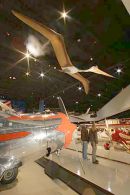



“DINO-SOAR!” digs into the very origins of flight, from the earliest flying insects and reptiles, and connects them to aviation today. The highly interactive exhibit includes artifacts and models ranging from the evolution of dinosaurs into birds that inspired modern-day aviation.
“This exhibit is something quite different for EAA and looks at flight in a way many of us have never considered,” said Alan Westby, EAA AirVenture Museum curator. “Through the DINO-SOAR! exhibit, people of all ages can discover, in a very fun way, how flight came to exist on Earth. It shows how the history of flight has been uninterrupted for millions of years, eventually creating the dreams and, quite recently, the reality of humans being able to fly.”
The 3,000-square foot exhibit will open along the museum’s Wittman Concourse and is included in regular museum admission. It will remain at EAA through April 2006. Among the fascinating items within the DINO-SOAR! exhibit are:
- A massive, 36-foot-wingspan model of a Quetzalcoatlus, the largest flying animal of all time. The model was built by famed aeronautical engineer Dr. Paul MacCready, who designed such legendary human- and solar-powered aircraft as the Gossamer Condor and Gossamer Albatross.
- Fossilized insects, bats and dragonflies; plus fascinating displays of amber-encased insects.
- Actual pterosaur fossils from the Jurassic period, highlighted by a flock of re-created pterosaurs overhead, showing the animals’ development over the 160 million years they ruled the sky.
- Lifelike models and reproductions from acclaimed dinosaur sculptor Allan Smith; and artwork of feathered dinosaurs by artist Luis Rey.
In addition, five interactive exhibits will engage young people and older enthusiasts:
- Explore a pterosaur nest! Reach inside a Pterodactyl nest and find whether you can identify what’s inside.
- Touch the oldest thing you’ve ever seen! Touch an actual dinosaur bone on display in the exhibit.
- Sit on a dinosaur egg! Sit inside a dinosaur nest while reading about prehistoric fliers.
- Become a fly! Hands-on exhibits show how an insect’s muscles and wings combine to let it fly.
- Build a dinosaur! Create your own prehistoric flier through hand-crafted dinosaur puzzles.
The EAA AirVenture Museum is located just off Highway 41 at the Highway 44 exit in Oshkosh. The Museum is open Monday through Saturday from 8:30 a.m. to 5 p.m. and on Sundays from 10 a.m. to 5 p.m. EAA members receive free museum admission year-round and family memberships are available. For more information, call the EAA AirVenture Museum at (920) 426-6108 or visit http://www.airventuremuseum.org/.
June 5, 2005
MORE (Birds' evolution)
EAA Aviation Center
